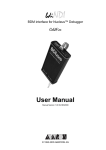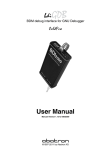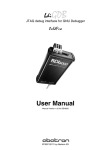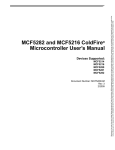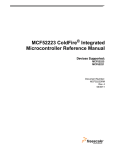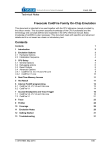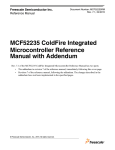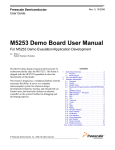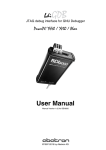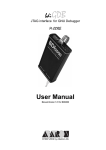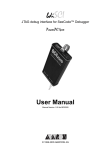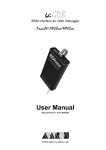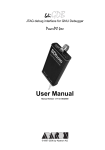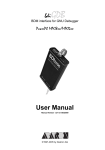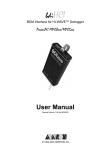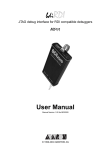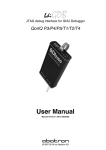Download bdiGDB_UserManual_ColdFire_33106
Transcript
bdi GDB BDM interface for GNU Debugger ColdFire User Manual Manual Version 1.10 for BDI2000 ©1997-2006 by Abatron AG bdiGDB for GNU Debugger, BDI2000 (ColdFire) User Manual 2 1 Introduction ................................................................................................................................. 3 1.1 BDI2000................................................................................................................................. 3 1.2 BDI Configuration .................................................................................................................. 4 2 Installation ................................................................................................................................... 5 2.1 Connecting the BDI2000 to Target......................................................................................... 5 2.1.1 Changing Target Processor Type ................................................................................. 7 2.2 Connecting the BDI2000 to Power Supply............................................................................. 8 2.2.1 External Power Supply ................................................................................................. 8 2.2.2 Power Supply from Target System ............................................................................... 9 2.3 Status LED «MODE»........................................................................................................... 10 2.4 Connecting the BDI2000 to Host ......................................................................................... 11 2.4.1 Serial line communication .......................................................................................... 11 2.4.2 Ethernet communication ............................................................................................ 12 2.5 Installation of the Configuration Software ............................................................................ 13 2.5.1 Configuration with a Linux / Unix host........................................................................ 15 2.5.2 Configuration with a Windows host ............................................................................ 17 2.5.3 Recover procedure..................................................................................................... 19 2.6 Testing the BDI2000 to host connection .............................................................................. 20 2.7 TFTP server for Windows NT............................................................................................... 20 3 Using bdiGDB ............................................................................................................................ 21 3.1 Principle of operation........................................................................................................... 21 3.2 Configuration File ................................................................................................................ 23 3.2.1 Part [INIT]................................................................................................................... 23 3.2.2 Part [TARGET] ........................................................................................................... 25 3.2.3 Part [HOST]................................................................................................................ 27 3.2.4 Part [FLASH] .............................................................................................................. 28 3.2.5 Part [REGS] ............................................................................................................... 33 3.3 Debugging with GDB ........................................................................................................... 35 3.3.1 Target setup................................................................................................................ 35 3.3.2 Connecting to the target............................................................................................. 35 3.3.3 Breakpoint Handling................................................................................................... 36 3.3.4 GDB monitor command.............................................................................................. 36 3.3.5 Target serial I/O via BDI ............................................................................................. 37 3.4 Telnet Interface .................................................................................................................... 38 4 Specifications ............................................................................................................................ 40 5 Environmental notice ................................................................................................................ 41 6 Declaration of Conformity (CE) ................................................................................................ 41 7 Warranty ..................................................................................................................................... 42 Appendices A Troubleshooting ........................................................................................................................ 43 B Maintenance .............................................................................................................................. 44 C Trademarks ................................................................................................................................ 46 © Copyright 1997-2006 by ABATRON AG Switzerland V 1.10 bdiGDB for GNU Debugger, BDI2000 (ColdFire) User Manual 3 1 Introduction bdiGDB enhances the GNU debugger (GDB), with Background Debug Mode (BDM) debugging for ColdFire based targets. With the built-in Ethernet interface you get a very fast code download speed of up to 150Kbytes/sec. No target communication channel (e.g. serial line) is wasted for debugging purposes. Even better, you can use fast Ethernet debugging with target systems without network capability. The host to BDI communication uses the standard GDB remote protocol. An additional Telnet interface is available for special debug tasks (e.g. force a hardware reset, program flash memory). The following figure shows how the BDI2000 interface is connected between the host and the target: Target System MCF 5307 BDM Interface BDI2000 UNIX / PC Host GNU Debugger (GDB) Abatron AG Swiss Made Ethernet (10 BASE-T) 1.1 BDI2000 The BDI2000 is the main part of the bdiGDB system. This small box implements the interface between the BDM pins of the target CPU and a 10Base-T Ethernet connector. The firmware and the programmable logic of the BDI2000 can be updated by the user with a simple Windows based configuration program. The BDI2000 supports 1.8 – 5.0 Volts target systems (3.0 – 5.0 Volts target systems with Rev. B). © Copyright 1997-2006 by ABATRON AG Switzerland V 1.10 bdiGDB for GNU Debugger, BDI2000 (ColdFire) User Manual 4 1.2 BDI Configuration As an initial setup, the IP address of the BDI2000, the IP address of the host with the configuration file and the name of the configuration file is stored within the flash of the BDI2000. Every time the BDI2000 is powered on, it reads the configuration file via TFTP. Following an example of a typical configuration file: ; Configuration file for a MCF5307 board ; -------------------------------------; the initialistion list used to setup the target system [INIT] WCREG 0xC0F 0x10000001 ;MBAR: map internal registers to 0x10000000 WCREG 0xC04 0x00800021 ;RAMBAR: map internal SRAM to 0x00800000 WM16 0x10000080 0xFFE0 ;CSAR0: Flash at 0xFFE00000 WM16 0x1000008A 0x0D80 ;CSCR0: Flash 3 waits, 16bit, WM32 0x10000084 0x000F0001 ;CSMR0: Flash 1MB, R/W, valid WM16 0x10000100 0x8230 ;DCR: SDRAM Trc=6, RC=48 WM32 0x10000108 0x00001300 ;DACR0: base=0x00000000; timing=2,4,2,1,-1; CBM=011 WM32 0x1000010C 0x003C0001 ;DCMR0: mask=4MB; enable WM32 0x10000108 0x00001308 ;DACR0: Initiate Precharge All Command WM32 0x00000400 0x00000000 ;Execute PALL command WM32 0x10000108 0x00009300 ;DACR0: enable refresh WM32 0x10000110 0x00401300 ;DACR1: base=0x00400000; timing=2,4,2,1,-1; CBM=011 WM32 0x10000114 0x007C0001 ;DCMR1: mask=8MB; enable WM32 0x10000110 0x00401308 ;DACR1: Initiate Precharge All Command WM32 0x00400400 0x00000000 ;Execute PALL command WM32 0x10000110 0x00409300 ;DACR1: enable refresh DELAY 20 ;Delay for Refresh WM32 0x10000108 0x00009340 ;DACR0: Initiate Mode Register Set Command WM32 0x00000400 0x00000000 ;Execute MRS command WM32 0x10000110 0x00009340 ;DACR1: Initiate Mode Register Set Command WM32 0x00400400 0x00000000 ;Execute MRS command [TARGET] CPUTYPE CPUCLOCK BREAKMODE VECTOR MCF5307 90000000 SOFT CATCH [HOST] IP FILE FORMAT LOAD 151.120.25.115 E:\cygnus\root\usr\demo\mcf5307\fibo.exe COFF MANUAL ;load code MANUAL or AUTO after reset [FLASH] WORKSPACE CHIPTYPE CHIPSIZE BUSWIDTH FILE ERASE ERASE 0x00800000 ;workspace in target RAM for fast programming algorithm AM29F ;Flash type (AM29F | AM29BX8 | AM29BX16 | I28BX8 | I28BX16) 0x80000 ;The size of one flash chip in bytes (e.g. AM29F010 = 0x20000) 16 ;The width of the flash memory bus in bits (8 | 16 | 32) D:\abatron\bdi360\ColdFire\pro\sbc5307.sss 0xFFE00000 ;erase sector 0 of flash 0xFFE20000 ;erase sector 1 of flash ;the CPU clock rate after processing the init list ;SOFT or HARD ;catch unhandled exceptions [REGS] DMM1 0x10000000 FILE E:\cygnus\root\usr\demo\mcf5307\reg5307.def Based on the information in the configuration file, the target is automatically initialized after every reset. © Copyright 1997-2006 by ABATRON AG Switzerland V 1.10 bdiGDB for GNU Debugger, BDI2000 (ColdFire) User Manual 5 2 Installation 2.1 Connecting the BDI2000 to Target The enclosed cable to the target system is designed for the Motorola recommended 26-pin Berg connector. In case where the target system has an appropriate connector, the cable can be directly connected. The pin assignment is in accordance with the Motorola specification. ! In order to ensure reliable operation of the BDI (EMC, runtimes, etc.) the target cable length must not exceed 20 cm (8"). Target System Target Connector Yellow Mark (Pin1) ColdFire 1 25 2 26 BDI2000 BDI Abatron AG TRGT MODE TARGET A TARGET B 15 1 16 2 Swiss Made The green LED «TRGT» marked light up when target is powered up 1 - NOT USED 2 - BKPT 3 - GROUND 4 - DSCLK 5 - GROUND 6 - NOT USED 7 - RESET 8 - DSI 9 - Vccio ** 10 - DSO 11 - NOT USED 12 - NOT USED 13 - NOT USED 14 - NOT USED 15 - NOT USED 16 - NOT USED 17 - NOT USED 18 - NOT USED 19 - NOT USED 20 - NOT USED 21 - NOT USED 22 - NOT USED 23 - NOT USED 24 - CLK_CPU* 25 - Vcore ** 26 - TEA * only needed for V2 cores ** see note The target CPU clock is only needed for older V2 cores (MCF5204, MCF5206(e) and MCF5272) because DSCLK and DSI have to change synchronous with the CPU clock. For all other cores, BDM communication can be asynchronous to the CPU clock and therefore this signal is not needed. Red Cable ! Important note for older target cables: The target cables delivered before October 2004 expect the target BDM reference voltage (Vccio) at pin 25 of the BDM connector. For target boards where Vccio is only routed to pin 9, remove the contact/wire from housing pin 25 and insert it into pin 9. lift Pin 9 Pin 25 © Copyright 1997-2006 by ABATRON AG Switzerland V 1.10 bdiGDB for GNU Debugger, BDI2000 (ColdFire) User Manual 6 BDI TARGET B Connector Signals: Pin Name 1 DSO 2 <reseved> 3 DSI 4 <reseved> 5 <reseved> 6 Vccio Target Describtion DATA SERIAL OUT For background debug mode, serial data output from the MCU. DATA SERIAL IN For background debug mode, serial data input signal to the MCU. 1.8 – 5.0V: This is the target reference voltage. It indicates that the target has power and it is also used to create the logic-level reference for the input comparators. It also controls the output logic levels to the target. It is normally fed from Vcc I/O on the target board. 3.0 – 5.0V with Rev. B : This input to the BDI2000 is used to detect if the target is powered up. If there is a current limiting resistor between this pin and the target Vdd, it should be 100 Ohm or less. 7 DSCLK DEVELOPMENT SERIAL CLOCK For background debug mode, serial shift clock to the MCU. 8 BKPT BREAKPOINT BKPT is an active-low signal that signals a hardware breakpoint for the ColdFire core. It is used to force the ColdFire core to enter debug mode. 9 TEA (optional) TRANSFER ERROR ACKNOWLEDGE (currently not implemented) Active-low open-drain signal, used to abort a bus cycle. This signal may be helpful for ColdFire devices which has no built-in bus monitor (e.g. MCF5307). The BDI is able to terminate an invalid memory access. Otherwise BDM communication may hang until a reset is applied. 10 <reseved> 11 <reseved> 12 GROUND System Ground 13 RESET RESET Active-low open-drain signal, used to force a system reset. 14 CLK_CPU PROCESSOR CLOCK For some cores, this clock signal is used to synchonize the BDM signals DSCLK and DSI. 15 <reseved> 16 GROUND System Ground Pin 14 is only use for some older V2 cores (MCF5204, MCF5206(e) and MCF5272). For all other cores this signal is not used. © Copyright 1997-2006 by ABATRON AG Switzerland V 1.10 bdiGDB for GNU Debugger, BDI2000 (ColdFire) User Manual 7 2.1.1 Changing Target Processor Type Before you can use the BDI2000 with an other target processor type (e.g. ColdFire <--> PPC), a new setup has to be done (see chapter 2.5). During this process the target cable must be disconnected from the target system. The BDI2000 needs to be supplied with 5 Volts via the BDI OPTION connector (Version A) or via the POWER connector (Version B). For more information see chapter 2.2.1 «External Power Supply». ! To avoid data line conflicts, the BDI2000 must be disconnected from the target system while programming the logic for an other target CPU. © Copyright 1997-2006 by ABATRON AG Switzerland V 1.10 bdiGDB for GNU Debugger, BDI2000 (ColdFire) User Manual 8 2.2 Connecting the BDI2000 to Power Supply 2.2.1 External Power Supply The BDI2000 needs to be supplied with 5 Volts (max. 1A) via the POWER connector. The available power supply from Abatron (option) or the enclosed power cable can be directly connected. In order to ensure reliable operation of the BDI2000, keep the power supply cable as short as possible. ! For error-free operation, the power supply to the BDI2000 must be between 4.75V and 5.25V DC. The maximal tolerable supply voltage is 5.25 VDC. Any higher voltage or a wrong polarity might destroy the electronics. Rev. B Version GND 3 1 Vcc 2 4 RS232 BDI TRGT MODE POWER Connector POWER LI TARGET A TX RX 10 BASE-T 1 - Vcc (+5V) 2 - VccTGT 3 - GROUND 4 - NOT USED TARGET B The green LED «BDI» marked light up when 5V power is connected to the BDI2000 Please switch on the system in the following sequence: • 1 --> external power supply • 2 --> target system © Copyright 1997-2006 by ABATRON AG Switzerland V 1.10 bdiGDB for GNU Debugger, BDI2000 (ColdFire) User Manual 9 2.2.2 Power Supply from Target System The BDI2000 needs to be supplied with 5 Volts (max. 1A) via TARGET B connector. This mode can only be used when the target system runs with 5V and the pin «Vcc Target» is able to deliver a current up to 1A@5V. For pin description and layout see chapter 2.1 «Connecting the BDI2000 to Target». Insert the enclosed Jumper as shown in figure below. Please ensure that the jumper is inserted correctly. ! For error-free operation, the power supply to the BDI2000 must be between 4.75V and 5.25V DC. The maximal tolerable supply voltage is 5.25 VDC. Any higher voltage or a wrong polarity might destroy the electronics. 3 1 2 4 RS232 BDI TRGT MODE POWER Connector POWER Jumper LI TARGET A TX RX 10 BASE-T 1 - Vcc BDI2000 (+5V) 2 - Vcc Target (+5V) 3 - GROUND 4 - NOT USED TARGET B The green LEDs «BDI» and «TRGT» marked light up when target is powered up and the jumper is inserted correctly © Copyright 1997-2006 by ABATRON AG Switzerland V 1.10 bdiGDB for GNU Debugger, BDI2000 (ColdFire) User Manual 10 2.3 Status LED «MODE» The built in LED indicates the following BDI states: BDI TRGT MODE TARGET A MODE LED TARGET B BDI STATES OFF The BDI is ready for use, the firmware is already loaded. ON The power supply for the BDI2000 is < 4.75VDC. BLINK The BDI «loader mode» is active (an invalid firmware is loaded or loading firmware is active). © Copyright 1997-2006 by ABATRON AG Switzerland V 1.10 bdiGDB for GNU Debugger, BDI2000 (ColdFire) User Manual 11 2.4 Connecting the BDI2000 to Host 2.4.1 Serial line communication Serial line communication is only used for the initial configuration of the bdiGDB system. The host is connected to the BDI through the serial interface (COM1...COM4). The communication cable (included) between BDI and Host is a serial cable. There is the same connector pinout for the BDI and for the Host side (Refer to Figure below). Target System RS232 Connector (for PC host) 12345 MCF 1 - NC 2 - RXD data from host 3 - TXD data to host 4 - NC 5 - GROUND 6 - NC 7 - NC 8 - NC 9 - NC 6789 RS232 POWER LI TX RX 10 BASE-T BDI2000 PC Host Abatron AG Swiss Made RS232 © Copyright 1997-2006 by ABATRON AG Switzerland V 1.10 bdiGDB for GNU Debugger, BDI2000 (ColdFire) User Manual 12 2.4.2 Ethernet communication The BDI2000 has a built-in 10 BASE-T Ethernet interface (see figure below). Connect an UTP (Unshilded Twisted Pair) cable to the BD2000. For thin Ethernet coaxial networks you can connect a commercially available media converter (BNC-->10 BASE-T) between your network and the BDI2000. Contact your network administrator if you have questions about the network. Target System 10 BASE-T Connector 1 - TD+ 2 - TD3 - RD+ 4 - NC 5 - NC 6 - RD7 - NC 8 - NC 1 RS232 POWER LI TX RX 8 MCF 10 BASE-T BDI2000 PC / Unix Host Abatron AG Swiss Made Ethernet (10 BASE-T) The following explains the meanings of the built-in LED lights: LED Name Description LI Link When this LED light is ON, data link is successful between the UTP port of the BDI2000 and the hub to which it is connected. TX Transmit When this LED light BLINKS, data is being transmitted through the UTP port of the BDI2000 RX Receive When this LED light BLINKS, data is being received through the UTP port of the BDI2000 © Copyright 1997-2006 by ABATRON AG Switzerland V 1.10 bdiGDB for GNU Debugger, BDI2000 (ColdFire) User Manual 13 2.5 Installation of the Configuration Software On the enclosed diskette you will find the BDI configuration software and the firmware required for the BDI2000. For Windows users there is also a TFTP server included. The following files are on the diskette. b20mcfgd.exe Configuration program (Windows application) b20mcfgd.hlp Windows help file for the configuration program b20mcfgd.xxx Firmware for the BDI2000 cf2jed20.xxx JEDEC file for the BDI (Rev. B) logic device (for old V2 cores) cf2jed21.xxx JEDEC file for the BDI (Rev. C) logic device (for old V2 cores) cf3jed20.xxx JEDEC file for the BDI (Rev. B) logic device cf3jed21.xxx JEDEC file for the BDI (Rev. C) logic device tftpsrv.exe TFTP server for Windows (WIN32 console application) *.cfg Sample configuration files *.def Register definition files bdisetup.zip ZIP Archive with the Setup Tool sources for Linux / UNIX hosts. Overview of an installation / configuration process: • Create a new directory on your hard disk • Copy the entire contents of the enclosed diskette into this directory • Linux only: extract the setup tool sources and build the setup tool • Use the setup tool to load/update the BDI firmware/logic Note: A new BDI has no firmware/logic loaded. • Use the setup tool to transmit the initial configuration parameters - IP address of the BDI. - IP address of the host with the configuration file. - Name of the configuration file. This file is accessed via TFTP. - Optional network parameters (subnet mask, default gateway). Activating BOOTP: The BDI can get the network configuration and the name of the configuration file also via BOOTP. For this simple enter 0.0.0.0 as the BDI’s IP address (see following chapters). If present, the subnet mask and the default gateway (router) is taken from the BOOTP vendor-specific field as defined in RFC 1533. With the Linux setup tool, simply use the default parameters for the -c option: [root@LINUX_1 bdisetup]# ./bdisetup -c -p/dev/ttyS0 -b57 The MAC address is derived from the serial number as follows: MAC: 00-0C-01-xx-xx-xx , repace the xx-xx-xx with the 6 left digits of the serial number Example: SN# 93123457 ==>> 00-0C-01-93-12-34 © Copyright 1997-2006 by ABATRON AG Switzerland V 1.10 bdiGDB for GNU Debugger, BDI2000 (ColdFire) User Manual 14 Important: Because some older V2 ColdFire cores (MCF5204, MCF5206(e) and MCF5272) need synchronous signals at the BDM interface, the BDI uses a different logic for this cores. Make sure that there is the correct logic loaded for the target CPU you are using. With the Windows setup tool, you can check a switch to select the correct logic file. The Linux/Unix setup tool looks for a file with the name mcfjed2x.xxx. Therefore copy first the correct logic file before updating the firmware/logic. For MCF5204, MCF5206(e), MCF5272 select the V2 logic file (check the Sync switch). Linux/Unix only: Before you can update the firmware/logic of the BDI, copy the correct JEDEC file to mcfjed2x.xxx: 5204, 5206(e), 5272: cf2jed20.102 -> mcfjed20.102 / cf2jed21.102 -> mcfjed21.102 All other cores: cf3jed20.102 -> mcfjed20.102 / cf3jed21.102 -> mcfjed21.102 © Copyright 1997-2006 by ABATRON AG Switzerland V 1.10 bdiGDB for GNU Debugger, BDI2000 (ColdFire) User Manual 15 2.5.1 Configuration with a Linux / Unix host The firmware / logic update and the initial configuration of the BDI2000 is done with a command line utility. In the ZIP Archive bdisetup.zip are all sources to build this utility. More information about this utility can be found at the top in the bdisetup.c source file. There is also a make file included. Starting the tool without any parameter displays information about the syntax and parameters. ! To avoid data line conflicts, the BDI2000 must be disconnected from the target system while programming the logic for an other target CPU (see Chapter 2.1.1). Following the steps to bring-up a new BDI2000: 1. Build the setup tool: The setup tool is delivered only as source files. This allows to build the tool on any Linux / Unix host. To build the tool, simply start the make utility. [root@LINUX_1 bdisetup]# make cc -O2 -c -o bdisetup.o bdisetup.c cc -O2 -c -o bdicnf.o bdicnf.c cc -O2 -c -o bdidll.o bdidll.c cc -s bdisetup.o bdicnf.o bdidll.o -o bdisetup 2. Check the serial connection to the BDI: With "bdisetup -v" you may check the serial connection to the BDI. The BDI will respond with information about the current loaded firmware and network configuration. Note: Login as root, otherwise you probably have no access to the serial port. [root@LINUX_1 bdisetup]# ./bdisetup -v -p/dev/ttyS0 -b57 BDI Type : BDI2000 Rev.C (SN: 92152150) Loader : V1.05 Firmware : unknown Logic : unknown MAC : ff-ff-ff-ff-ff-ff IP Addr : 255.255.255.255 Subnet : 255.255.255.255 Gateway : 255.255.255.255 Host IP : 255.255.255.255 Config : ?????????????????? 3. Load/Update the BDI firmware/logic: With "bdisetup -u" the firmware is loaded and the CPLD within the BDI2000 is programmed. This configures the BDI for the target you are using. Based on the parameters -a and -t, the tool selects the correct firmware / logic files. If the firmware / logic files are in the same directory as the setup tool, there is no need to enter a -d parameter. [root@LINUX_1 bdisetup]# cp cf3jed21.103 mcfjed21.103 [root@LINUX_1 bdisetup]# ./bdisetup -u -p/dev/ttyS0 -b57 -aGDB -tMCF Connecting to BDI loader Erasing CPLD Programming firmware with ./b20mcfgd.100 Programming CPLD with ./mcfjed21.103 © Copyright 1997-2006 by ABATRON AG Switzerland V 1.10 bdiGDB for GNU Debugger, BDI2000 (ColdFire) User Manual 16 4. Transmit the initial configuration parameters: With "bdisetup -c" the configuration parameters are written to the flash memory within the BDI. The following parameters are used to configure the BDI: BDI IP Address The IP address for the BDI2000. Ask your network administrator for assigning an IP address to this BDI2000. Every BDI2000 in your network needs a different IP address. Subnet Mask The subnet mask of the network where the BDI is connected to. A subnet mask of 255.255.255.255 disables the gateway feature. Ask your network administrator for the correct subnet mask. If the BDI and the host are in the same subnet, it is not necessary to enter a subnet mask. Default Gateway Enter the IP address of the default gateway. Ask your network administrator for the correct gateway IP address. If the gateway feature is disabled, you may enter 255.255.255.255 or any other value. Config - Host IP Address Enter the IP address of the host with the configuration file. The configuration file is automatically read by the BDI2000 after every start-up. Configuration file Enter the full path and name of the configuration file. This file is read via TFTP. Keep in mind that TFTP has it’s own root directory (usual /tftpboot). You can simply copy the configuration file to this directory and the use the file name without any path. For more information about TFTP use "man tftpd". [root@LINUX_1 bdisetup]# ./bdisetup -c -p/dev/ttyS0 -b57 \ > -i151.120.25.101 \ > -h151.120.25.118 \ > -fmcf5307.cnf Connecting to BDI loader Writing network configuration Writing init list and mode Configuration passed 5. Check configuration and exit loader mode: The BDI is in loader mode when there is no valid firmware loaded or you connect to it with the setup tool. While in loader mode, the Mode LED is flashing. The BDI will not respond to network requests while in loader mode. To exit loader mode, the "bdisetup -v -s" can be used. You may also power-off the BDI, wait some time (1min.) and power-on it again to exit loader mode. [root@LINUX_1 bdisetup]# ./bdisetup -v -p/dev/ttyS0 -b57 -s BDI Type : BDI2000 Rev.C (SN: 92152150) Loader : V1.05 Firmware : V1.00 bdiGDB for ColdFire Logic : V1.03 ColdFire MAC : 00-0c-01-92-15-21 IP Addr : 151.120.25.101 Subnet : 255.255.255.255 Gateway : 255.255.255.255 Host IP : 151.120.25.118 Config : mcf5307.cnf The Mode LED should go off, and you can try to connect to the BDI via Telnet. [root@LINUX_1 bdisetup]# telnet 151.120.25.101 © Copyright 1997-2006 by ABATRON AG Switzerland V 1.10 bdiGDB for GNU Debugger, BDI2000 (ColdFire) User Manual 17 2.5.2 Configuration with a Windows host First make sure that the BDI is properly connected (see Chapter 2.1 to 2.4). ! To avoid data line conflicts, the BDI2000 must be disconnected from the target system while programming the logic for an other target CPU (see Chapter 2.1.1). dialog box «BDI2000 Update/Setup» Before you can use the BDI2000 together with the GNU debugger, you must store the initial configuration parameters in the BDI2000 flash memory. The following options allow you to do this: Channel Select the communication port where the BDI2000 is connected during this setup session. Baudrate Select the baudrate used to communicate with the BDI2000 loader during this setup session. Connect Click on this button to establish a connection with the BDI2000 loader. Once connected, the BDI2000 remains in loader mode until it is restarted or this dialog box is closed. Current Press this button to read back the current loaded BDI2000 software and logic versions. The current loader, firmware and logic version will be displayed. Update This button is only active if there is a newer firmware or logic version present in the execution directory of the bdiGDB setup software. Press this button to write the new firmware and/or logic into the BDI2000 flash memory / programmable logic. © Copyright 1997-2006 by ABATRON AG Switzerland V 1.10 bdiGDB for GNU Debugger, BDI2000 (ColdFire) User Manual 18 Synch Because some older V2 ColdFire cores (e.g. MCF5272) need synchronous signals at the BDM interface, the BDI uses a different logic for this cores. Check this box only if your target is a MCF5204, MCF5206, MCF5206e or MCF5272. The BDI automatically selects the correct JEDEC file. Make sure that there is the correct logic loaded for the target CPU you are using. BDI IP Address Enter the IP address for the BDI2000. Use the following format: xxx.xxx.xxx.xxx e.g.151.120.25.101 Ask your network administrator for assigning an IP address to this BDI2000. Every BDI2000 in your network needs a different IP address. Subnet Mask Enter the subnet mask of the network where the BDI is connected to. Use the following format: xxx.xxx.xxx.xxxe.g.255.255.255.0 A subnet mask of 255.255.255.255 disables the gateway feature. Ask your network administrator for the correct subnet mask. Default Gateway Enter the IP address of the default gateway. Ask your network administrator for the correct gateway IP address. If the gateway feature is disabled, you may enter 255.255.255.255 or any other value.. Config - Host IP Address Enter the IP address of the host with the configuration file. The configuration file is automatically read by the BDI2000 after every start-up. Configuration file Enter the full path and name of the configuration file. e.g. D:\gnu\config\bdi\ads860bdi.cnf For information about the syntax of the configuration file see the bdiGDB User manual. This name is transmitted to the TFTP server when reading the configuration file. Transmit Click on this button to store the configuration in the BDI2000 flash memory. © Copyright 1997-2006 by ABATRON AG Switzerland V 1.10 bdiGDB for GNU Debugger, BDI2000 (ColdFire) User Manual 19 2.5.3 Recover procedure In rare instances you may not be able to load the firmware in spite of a correctly connected BDI (error of the previous firmware in the flash memory). Before carrying out the following procedure, check the possibilities in Appendix «Troubleshooting». In case you do not have any success with the tips there, do the following: • Switch OFF the power supply for the BDI and open the unit as described in Appendix «Maintenance» • Place the jumper in the «INIT MODE» position • Connect the power cable or target cable if the BDI is powered from target system • Switch ON the power supply for the BDI again and wait until the LED «MODE» blinks fast INIT MODE • Turn the power supply OFF again DEFAULT • Return the jumper to the «DEFAULT» position • Reassemble the unit as described in Appendix «Maintenance» © Copyright 1997-2006 by ABATRON AG Switzerland V 1.10 bdiGDB for GNU Debugger, BDI2000 (ColdFire) User Manual 20 2.6 Testing the BDI2000 to host connection After the initial setup is done, you can test the communication between the host and the BDI2000. There is no need for a target configuration file and no TFTP server is needed on the host. • If not already done, connect the bdiGDB system to the network. • Power-up the BDI2000. • Start a Telnet client on the host and connect to the BDI2000 (the IP address you entered during initial configuration). • If everything is okay, a sign on message like «BDI Debugger for ColdFire» and a list of the available commands should be displayed in the Telnet window. 2.7 TFTP server for Windows NT The bdiGDB system uses TFTP to access the configuration file and to load the application program. Because there is no TFTP server bundled with Windows NT, Abatron provides a TFTP server application tftpsrv.exe. This WIN32 console application runs as normal user application (not as a system service). Command line syntax: tftpsrv [p] [w] [dRootDirectory] Without any parameter, the server starts in read-only mode. This means, only read access request from the client are granted. This is the normal working mode. The bdiGDB system needs only read access to the configuration and program files. The parameter [p] enables protocol output to the console window. Try it. The parameter [w] enables write accesses to the host file system. The parameter [d] allows to define a root directory. tftpsrv p Starts the TFTP server and enables protocol output tftpsrv p w Starts the TFTP server, enables protocol output and write accesses are allowed. tftpsrv dC:\tftp\ Starts the TFTP server and allows only access to files in C:\tftp and its subdirectories. As file name, use relative names. For example "bdi\mpc750.cfg" accesses "C:\tftp\bdi\mpc750.cfg" You may enter the TFTP server into the Startup group so the server is started every time you logon. © Copyright 1997-2006 by ABATRON AG Switzerland V 1.10 bdiGDB for GNU Debugger, BDI2000 (ColdFire) User Manual 21 3 Using bdiGDB 3.1 Principle of operation The firmware within the BDI handles the GDB request and accesses the target memory or registers via the BDM interface. There is no need for any debug software on the target system. After loading the code via TFTP debugging can begin at the very first assembler statement. Whenever the BDI system is powered-up the following sequence starts: Power On initial configuration valid? no yes activate BDI2000 loader Get configuration file via TFTP Power OFF Process target init list Load program code via TFTP and set the PC RUN selected? Start loaded program code Process GDB request Power OFF © Copyright 1997-2006 by ABATRON AG Switzerland V 1.10 bdiGDB for GNU Debugger, BDI2000 (ColdFire) User Manual 22 Breakpoints: There are two breakpoint modes supported. One of them (SOFT) is implemented by replacing application code with a HALT instruction. The other (HARD) uses the built in breakpoint logic. If HARD is used, only up to 1 ( 4 for V4 cores ) breakpoints can be active at the same time. The following example selects SOFT as the breakpoint mode: BREAKMODE SOFT ;<AGENT> SOFT or HARD, HARD uses PPC hardware breakpoints All the time the application is suspended (i.e. caused by a breakpoint) the target processor remains freezed. Target Exceptions: If enabled, the BDI will catch all unhandled exceptions. This is only possible if the vector table is writable. At vector 0 the BDI writes a HALT, RTE instruction sequence and lets all other vectors point to this short exception handler. The BDI reads back the VBR after processing the initilaisation list in order to get the base address of the vector table. [INIT] WCREG 0x801 [TARGET] VECTOR CATCH 0x00000000 ;set vector base ;enable vector catching © Copyright 1997-2006 by ABATRON AG Switzerland V 1.10 bdiGDB for GNU Debugger, BDI2000 (ColdFire) User Manual 23 3.2 Configuration File The configuration file is automatically read by the BDI after every power on. The syntax of this file is as follows: ; comment [part name] identifier parameter1 identifier parameter1 ..... [part name] identifier parameter1 identifier parameter1 ..... etc. parameter2 ..... parameterN parameter2 ..... parameterN ; comment parameter2 ..... parameterN parameter2 ..... parameterN Numeric parameters can be entered as decimal (e.g. 700) or as hexadecimal (0x80000). 3.2.1 Part [INIT] The part [INIT] defines a list of commands which should be executed every time the target comes out of reset. The commands are used to get the target ready for loading the program file. The SIM registers (chip select, clock, ...) are usually initialized with this command list. WDREG register value Write value to the selected data register. register the register number 0 .. 7 value the value to write into the register Example: WDREG 0 5 WAREG register value Write value to the selected address register. register the register number 0 .. 7 value the value to write into the register Example: WAREG 0 5 WCREG register value Write value to the selected control register. register the register number(e.g. 0x801 for VBR) value the value to write into the register Example: WCREG 0xC0F 0x10000001 ;MBAR WM8 address value Write a byte (8bit) to the selected memory place. address the memory address value the value to write to the target memory Example: WM8 0xFFFFFA21 0x04 ; SYPCR: watchdog disable ... WM16 address value Write a half word (16bit) to the selected memory place. address the memory address value the value to write to the target memory Example: WM16 0x10000100 0x8230 ;DCR © Copyright 1997-2006 by ABATRON AG Switzerland V 1.10 bdiGDB for GNU Debugger, BDI2000 (ColdFire) User Manual 24 WM32 address value Write a word (32bit) to the selected memory place. address the memory address value the value to write to the target memory Example: WM32 0x1000010C 0x003C0001 ;DCMR0 MMAP start end Because a memory access to an invalid memory space via BDM can lead to a deadlock, this entry can be used to define up to 32 valid memory ranges. If at least one memory range is defined, the BDI checks against this range(s) and avoids accessing of not mapped memory ranges. start the start address of a valid memory range end the end address of this memory range Example: MMAP 0xFFE00000 0xFFFFFFFF ;Boot ROM DELAY value Delay for the selected time. A delay may be necessary to let the clock PLL lock again after a new clock rate is selected. value the delay time in milliseconds (1...30000) Example: DELAY 500 ; delay for 0.5 seconds WTLB tag data Only V4e cores: Adds an entry to the TLB array(s). For a detailed description of the tag/data value look at the V4e MMU description. The first WTLB entry in the init list also clears the hole TLB array. tag virtual page number, ASID, shared and valid bit data real page number, size, cache mode and SRWXL bits Example: WTLB 0x00000001 0x1001025C ;SRAM 8k CB RWX MMU setup example: NOP WCREG WCREG WCREG WCREG NOP WTLB WTLB WTLB WTLB WTLB WTLB WTLB WTLB NOP WTLB WTLB WTLB WTLB WM32 0x0C0F 0x0008 0x0C04 0x0C05 0x10000001 0x11000001 0x20000035 0x20001035 0x10000001 0x10002001 0x10004001 0x10006001 0x10008001 0x1000A001 0x1000C001 0x1000E001 0x10000298 0x10020298 0x10040298 0x10060298 0x10080298 0x100A0298 0x100C0298 0x100E0298 0x00000001 0x00002001 0x00004001 0x00006001 0x11000000 0x1001025C 0x1001225C 0x1001425C 0x1001625C 0x00000001 ;Set Memory Map ;MBAR : map internal REGS to 0x10000000 ;MMUBAR : map MMU registers to 0x11000000 ;RAMBAR0: map internal SRAM to 0x20000000 ;RAMBAR1: map internal SRAM to 0x20001000 ;MMU : Map internal registers ;0x10000000 -> 0x10000000, 8k, NP, RW;0x10002000 -> 0x10002000, 8k, NP, RW;0x10004000 -> 0x10004000, 8k, NP, RW;0x10006000 -> 0x10006000, 8k, NP, RW;0x10008000 -> 0x10008000, 8k, NP, RW;0x1000A000 -> 0x1000A000, 8k, NP, RW;0x1000C000 -> 0x1000C000, 8k, NP, RW;0x1000E000 -> 0x1000E000, 8k, NP, RW;MMU : Map 32k System RAM to 0x00000000 ;0x00000000 -> 0x10010000, 8k, CB, RWX ;0x00002000 -> 0x10012000, 8k, CB, RWX ;0x00004000 -> 0x10014000, 8k, CB, RWX ;0x00008000 -> 0x10016000, 8k, CB, RWX ;MMUCR: enable MMU © Copyright 1997-2006 by ABATRON AG Switzerland V 1.10 bdiGDB for GNU Debugger, BDI2000 (ColdFire) User Manual 25 3.2.2 Part [TARGET] The part [TARGET] defines some target specific values. CPUTYPE type This value gives the BDI information about the connected CPU. type MCF5202, MCF5203, MCF5204, MCF5206, MCF5272 MCF5207, MCF5208, MCF5214, MCF5216, MCF5249, SCF5250, MCF5251, MCF5253 MCF5230, MCF5232, MCF5234, MCF5235 MCF5270, MCF5271, MCF5274, MCF5275 MCF5280, MCF5281, MCF5282 MCF5307, MCF5407, MCF5470, MCF5480 MCF5211, MCF5212, MCF5213, MCF5223, MCF5327, MCF5328, MCF5329, MCF5372, MCF5373 Example: CPUTYPE MCF5282 BDIMODE mode param This parameter selects the BDI debugging mode. The following modes are supported: LOADONLY Loads and starts the application core. No debugging via BDM. AGENT The debug agent runs within the BDI. There is no need for any debug software on the target. This mode accepts a second parameter. If RUN is entered as a second parameter, the loaded application will be started immediately, otherwise only the PC is set and BDI waits for GDB requests. Example: BDIMODE AGENT RUN CPUCLOCK value The BDI needs to know how fast the target CPU runs after processing the init list. The BDM communication speed is selected based on this value. If this value defines a clock rate that is higher than the real clock, BDM communication may fail. When defining a clock rate slower than possible, BDM communication still works but not as fast as possible. For V3/V4 cores, enter the PSTCLK value. value the CPU (PSTCLK) clock in hertz Example: CPUCLOCK 25000000 ; CPU clock is 25.0MHz STARTUP mode [runtime] This parameter selects the target startup mode. The following modes are supported: RESET This default mode forces the target to debug mode immediately out of reset. No code is executed after reset. STOP In this mode, the BDI lets the target execute code for "runtime" milliseconds after reset. This mode is useful when monitor code should initialize the target system. RUN After reset, the target executes code until stopped by the Telnet "halt" command. Example: STARTUP STOP 3000 ; let the CPU run for 3 seconds © Copyright 1997-2006 by ABATRON AG Switzerland V 1.10 bdiGDB for GNU Debugger, BDI2000 (ColdFire) User Manual 26 BREAKMODE mode This parameter defines how breakpoints are implemented. The current mode can also be changed via the Telnet interface. SOFT This is the normal mode. Breakpoints are implemented by replacing code with a TRAP instruction. HARD In this mode, the PPC breakpoint hardware is used. Only 1 (4) breakpoints at a time are supported. Example: BREAKMODE HARD ; enable use of break hardware VECTOR CATCH When this line is present, the BDI catches all unhandled exceptions. Catching exceptions is only possible if the vector table is writable. Example: VECTOR CATCH ; catch unhandled exception SIO port [baudrate] When this line is present, a TCP/IP channel is routed to the BDI’s RS232 connector. The port parameter defines the TCP port used for this BDI to host communication. You may choose any port except 0 and the default Telnet port (23). On the host, open a Telnet session using this port. Now you should see the UART output in this Telnet session. You can use the normal Telnet connection to the BDI in parallel, they work completely independent. Also input to the UART is implemented. port The TCP/IP port used for the host communication. baudrate The BDI supports 2400 ... 115200 baud Example: SIO 7 9600 ;TCP port for virtual IO WAKEUP time This entry in the init list allows to define a delay time (in ms) the BDI inserts between releasing the RESET line and starting communicating with the target. This init list entry may be necessary if RESET is delayed on its way to the processors reset pin. time the delay time in milliseconds Example: WAKEUP 3000 ; insert 3sec wake-up time RESET time This entry in the init list allows to define the time (in ms) the BDI asserts the RESET signal. time the reset time in milliseconds Example: RESET 500 ; assert RESET for 500 ms © Copyright 1997-2006 by ABATRON AG Switzerland V 1.10 bdiGDB for GNU Debugger, BDI2000 (ColdFire) User Manual 27 3.2.3 Part [HOST] The part [HOST] defines some host specific values. IP ipaddress The IP address of the host. ipaddress the IP address in the form xxx.xxx.xxx.xxx Example: IP 151.120.25.100 FILE filename The default name of the file that is loaded into RAM using the Telnet ’load’ command. This name is used to access the file via TFTP. If the filename starts with a $, this $ is replace with the path of the configuration file name. filename the filename including the full path or $ for relative path. Example: FILE F:\gnu\demo\mcf\test.elf FILE $test.elf FORMAT format [offset] The format of the program file and an optional load address offset. Currently binary, S-record, a.out, ELF and COFF formats are supported. If the code is already stored in ROM on the target, select ROM as the format. The optional parameter "offset" is added to any load address read from the image file. format BIN, SREC, AOUT, ELF, COFF or ROM Example: FORMAT COFF FORMAT COFF 0x10000 LOAD mode In Agent mode, this parameters defines if the code is loaded automatically after every reset. mode AUTO, MANUAL Example: LOAD MANUAL START address The address where to start the program file. If this value is not defined and the core is not in ROM, the address is taken from the code file. If this value is not defined and the core is already in ROM, the PC will not be set before starting the program file. This means, the program starts at the normal reset address (0x0100). address the address where to start the program file Example: START 0x1000 DEBUGPORT port The TCP port GDB uses to access the target. port the TCP port number (default = 2001) Example: DEBUGPORT 2001 PROMPT string This entry defines a new Telnet prompt. The current prompt can also be changed via the Telnet interface. Example: PROMPT 5307> DUMP filename The default file name used for the Telnet DUMP command. filename the filename including the full path Example: DUMP dump.bin © Copyright 1997-2006 by ABATRON AG Switzerland V 1.10 bdiGDB for GNU Debugger, BDI2000 (ColdFire) User Manual 28 3.2.4 Part [FLASH] The Telnet interface supports programming and erasing of flash memories. The bdiGDB system has to know which type of flash is used, how the chip(s) are connected to the CPU and which sectors to erase in case the ERASE command is entered without any parameter . CHIPTYPE type This parameter defines the type of flash used. It is used to select the correct programming algorithm. format AM29F, AM29BX8, AM29BX16, I28BX8, I28BX16, AT49, AT49X8, AT49X16, STRATAX8, STRATAX16, MIRROR, MIRRORX8, MIRRORX16, AM29DX16, AM29DX32 Example: CHIPTYPE AM29F CHIPSIZE size The size of one flash chip in bytes (e.g. AM29F010 = 0x20000). This value is used to calculate the starting address of the current flash memory bank. size the size of one flash chip in bytes Example: CHIPSIZE 0x80000 BUSWIDTH width Enter the width of the memory bus that leads to the flash chips. Do not enter the width of the flash chip itself. The parameter CHIPTYPE carries the information about the number of data lines connected to one flash chip. For example, enter 16 if you are using two AM29F010 to build a 16bit flash memory bank. with the width of the flash memory bus in bits (8 | 16 | 32) Example: BUSWIDTH 16 FILE filename The default name of the file that is programmed into flash using the Telnet ’prog’ command. This name is used to access the file via TFTP. If the filename starts with a $, this $ is replace with the path of the configuration file name. This name may be overridden interactively at the Telnet interface. filename the filename including the full path or $ for relative path. Example: FILE F:\gnu\mcf\bootrom.hex FILE $bootrom.hex FORMAT format [offset] The format of the file and an optional address offset. The optional parameter "offset" is added to any load address read from the program file. format SREC, BIN, AOUT, ELF or COFF Example: FORMAT SREC FORMAT ELF 0x10000 © Copyright 1997-2006 by ABATRON AG Switzerland V 1.10 bdiGDB for GNU Debugger, BDI2000 (ColdFire) WORKSPACE address User Manual 29 If a workspace is defined, the BDI uses a faster programming algorithm that runs out of RAM on the target system. Otherwise, the algorithm is processed within the BDI. The workspace is used for a 1kByte data buffer and to store the algorithm code. There must be at least 2kBytes of RAM available for this purpose. address the address of the RAM area Example: WORKSPACE 0x00000000 ERASE addr [increment count] [mode [wait]] The flash memory may be individually erased or unlocked via the Telnet interface. In order to make erasing of multiple flash sectors easier, you can enter an erase list. All entries in the erase list will be processed if you enter ERASE at the Telnet prompt without any parameter. This list is also used if you enter UNLOCK at the Telnet without any parameters. With the "increment" and "count" option you can erase multiple equal sized sectors with one entry in the erase list. address Address of the flash sector, block or chip to erase increment If present, the address offset to the next flash sector count If present, the number of equal sized sectors to erase mode BLOCK, CHIP, UNLOCK Without this optional parameter, the BDI executes a sector erase. If supported by the chip, you can also specify a block or chip erase. If UNLOCK is defined, this entry is also part of the unlock list. This unlock list is processed if the Telnet UNLOCK command is entered without any parameters. wait The wait time in ms is only used for the unlock mode. After starting the flash unlock, the BDI waits until it processes the next entry. Example: ERASE 0xff040000 ;erase sector 4 of flash ERASE 0xff060000 ;erase sector 6 of flash ERASE 0xff000000 CHIP ;erase whole chip(s) ERASE 0xff010000 UNLOCK 100 ;unlock, wait 100ms ERASE 0xff000000 0x10000 7 ; erase 7 sectors Example for the MCF5307 evaluation board flash memory: [FLASH] WORKSPACE CHIPTYPE CHIPSIZE BUSWIDTH FILE ERASE ERASE ERASE ERASE 0x00800000 ;workspace in target RAM for fast programming algorithm AM29F ;Flash type (AM29F | AM29BX8 | AM29BX16 | I28BX8 | I28BX16) 0x80000 ;The size of one flash chip in bytes (e.g. AM29F010 = 0x20000) 16 ;The width of the flash memory bus in bits (8 | 16 | 32) D:\abatron\bdi360\ColdFire\pro\sbc5307.sss 0xFFE00000 ;erase sector 0 of flash 0xFFE20000 ;erase sector 1 of flash 0xFFE40000 ;erase sector 1 of flash 0xFFE60000 ;erase sector 1 of flash the above erase list maybe replaces with: ERASE 0xFFE00000 0x20000 4 ;erase 4 sectors © Copyright 1997-2006 by ABATRON AG Switzerland V 1.10 bdiGDB for GNU Debugger, BDI2000 (ColdFire) User Manual 30 Supported Flash Memories: There are currently 3 standard flash algorithm supported. The AMD, Intel and Atmel AT49 algorithm. Almost all currently available flash memories can be programmed with one of this algorithm. The flash type selects the appropriate algorithm and gives additional information about the used flash. For 8bit only flash: AM29F (MIRROR), I28BX8, AT49 For 8/16 bit flash in 8bit mode: AM29BX8 (MIRRORX8), I28BX8 (STRATAX8), AT49X8 For 8/16 bit flash in 16bit mode: AM29BX16 (MIRRORX16), I28BX16 (STRATAX16), AT49X16 For 16bit only flash: AM29BX16, I28BX16, AT49X16 For 16/32 bit flash in 16bit mode: AM29DX16 For 16/32 bit flash in 32bit mode: AM29DX32 The AMD and AT49 algorithm are almost the same. The only difference is, that the AT49 algorithm does not check for the AMD status bit 5 (Exceeded Timing Limits). Only the AMD and AT49 algorithm support chip erase. Block erase is only supported with the AT49 algorithm. If the algorithm does not support the selected mode, sector erase is performed. If the chip does not support the selected mode, erasing will fail. The erase command sequence is different only in the 6th write cycle. Depending on the selected mode, the following data is written in this cycle (see also flash data sheets): 0x10 for chip erase, 0x30 for sector erase, 0x50 for block erase. To speed up programming of Intel Strata Flash and AMD MirrorBit Flash, an additional algorithm is implemented that makes use of the write buffer. This algorithm needs a workspace, otherwise the standard Intel/AMD algorithm is used. The following table shows some examples: Flash x8 x 16 x 32 Chipsize AM29F - - 0x020000 Am29F800B AM29BX8 AM29BX16 - 0x100000 Am29DL323C AM29BX8 AM29BX16 - 0x400000 Am29PDL128G - AM29DX16 AM29DX32 0x01000000 Intel 28F032B3 I28BX8 - - 0x400000 Intel 28F640J3A STRATAX8 STRATAX16 - 0x800000 Intel 28F320C3 - I28BX16 - 0x400000 AT49BV040 AT49 - - 0x080000 AT49BV1614 AT49X8 AT49X16 - 0x200000 M58BW016BT - - M58X32 0x200000 SST39VF160 - AT49X16 - 0x200000 Am29LV320M MIRRORX8 MIRRORX16 - 0x400000 Am29F010 © Copyright 1997-2006 by ABATRON AG Switzerland V 1.10 bdiGDB for GNU Debugger, BDI2000 (ColdFire) User Manual 31 Note: Some Intel flash chips (e.g. 28F800C3, 28F160C3, 28F320C3) power-up with all blocks in locked state. In order to erase/program those flash chips, use the init list to unlock the appropriate blocks: WM16 WM16 WM16 WM16 WM16 0xFFF00000 0xFFF00000 0xFFF10000 0xFFF10000 .... 0xFFF00000 0x0060 0x00D0 0x0060 0x00D0 unlock block 0 0xFFFF select read mode unlock block 1 or use the Telnet "unlock" command: UNLOCK [<addr> [<delay>]] addr This is the address of the sector (block) to unlock delay A delay time in milliseconds the BDI waits after sending the unlock command to the flash. For example, clearing all lock-bits of an Intel J3 Strata flash takes up to 0.7 seconds. If "unlock" is used without any parameter, all sectors in the erase list with the UNLOCK option are processed. To clear all lock-bits of an Intel J3 Strata flash use for example: BDI> unlock 0xFF000000 1000 To erase or unlock multiple, continuos flash sectors (blocks) of the same size, the following Telnet commands can be used: ERASE <addr> <step> <count> UNLOCK <addr> <step> <count> addr This is the address of the first sector to erase or unlock. step This value is added to the last used address in order to get to the next sector. In other words, this is the size of one sector in bytes. count The number of sectors to erase or unlock. The following example unlocks all 256 sectors of an Intel Strata flash (28F256K3) that is mapped to 0x00000000. In case there are two flash chips to get a 32bit system, double the "step" parameter. BDI> unlock 0x00000000 0x20000 256 © Copyright 1997-2006 by ABATRON AG Switzerland V 1.10 bdiGDB for GNU Debugger, BDI2000 (ColdFire) User Manual 32 MCF5282 internal flash (CFM): To erase and program the ColdFire Flash Module (CFM) you have to access it via the backdoor addresses (IPSBAR + 0x04000000). This backdoor address has to be used for erase and program commands. Following an example how to setup for CFM programming when IPSBAR is at the default address off 0x40000000. [FLASH] WORKSPACE CHIPTYPE BUSWIDTH FILE FORMAT ERASE ERASE 0x20000000 ;workspace in target SRAM for fast programming algorithm CFM ;MCF5282 internal flash 32 ;The width of the flash memory bus in bits (8 | 16 | 32) E:\cygwin\home\bdidemo\coldfire\evb5282_cmf.bin BIN 0x44000000 0x44000000 MASS 0x44040000 MASS Before you can erase/program the CFM, the CFM Clock Divider needs to be setup via an init list entry. Check the MCF5282 user’s manual about how to setup the CFMCLKD. WM8 0x401D0002 0x54 ;CFMCLKD : Flash clock divider for 64MHz © Copyright 1997-2006 by ABATRON AG Switzerland V 1.10 bdiGDB for GNU Debugger, BDI2000 (ColdFire) User Manual 33 3.2.5 Part [REGS] In order to make it easier to access target registers via the Telnet interface, the BDI can read in a register definition file. In this file, the user defines a name for the register and how the BDI should access it (e.g. as memory mapped, memory mapped with offset, ...). The name of the register definition file and information for different registers type has to be defined in the configuration file. The register name, type, address/offset/number and size are defined in a separate register definition file. This way, you can create one register definition file for the MCF5307 that can be used for all possible positions of the internal memory map. You only have to change one entry in the configuration file. An entry in the register definition file has the following syntax: name type addr size name The name of the register (max. 12 characters) type The register type DREG AREG CREG MM DMM1...DMM4 IMM1...IMM4 Data register Address register Control register Absolute direct memory mapped register Relative direct memory mapped register Indirect memory mapped register addr The address, offset or number of the register size The size (8, 16, 32) of the register The following entries are supported in the [REGS] part of the configuration file: FILE filename The name of the register definition file. This name is used to access the file via TFTP. The file is loaded once during BDI startup. filename the filename including the full path Example: FILE C:\bdi\regs\mpc8260.def DMMn base This defines the base address of direct memory mapped registers. This base address is added to the individual offset of the register. base the base address Example: DMM1 0x01000 IMMn addr data This defines the addresses of the memory mapped address and data registers of indirect memory mapped registers. The address of a IMMn register is first written to "addr" and then the register value is access using "data" as address. addr the address of the Address register data the address of the Data register Example: DMM1 0x02200000 Note: The following register names are already predefined: d0 .. d7, a0 .. a7, fp, sp, vbr, sr, pc, cacr, acr0, acr1, rambar, rombar, mbar © Copyright 1997-2006 by ABATRON AG Switzerland V 1.10 bdiGDB for GNU Debugger, BDI2000 (ColdFire) User Manual 34 Example for a register definition (MCF5307): Entry in the configuration file: [REGS] DMM1 0x10000000 FILE E:\cygnus\root\usr\demo\mcf5307\reg5307.def The register definition file: ;name type addr size ;------------------------------------------; ; ; DMM1 must be set to the internal memory map base address ; ; System Integration Module rsr DMM1 0x000 8 sypcr DMM1 0x001 8 swivr DMM1 0x002 8 swsr DMM1 0x004 8 par DMM1 0x004 16 iqpar DMM1 0x006 8 pllcr DMM1 0x008 8 mpark DMM1 0x00c 8 ipr DMM1 0x040 32 imr DMM1 0x044 32 avr DMM1 0x04b 8 icr0 DMM1 0x04c 8 icr1 DMM1 0x04d 8 icr2 DMM1 0x04e 8 icr3 DMM1 0x04f 8 icr4 DMM1 0x050 8 icr5 DMM1 0x051 8 icr6 DMM1 0x052 8 icr7 DMM1 0x053 8 icr8 DMM1 0x054 8 icr9 DMM1 0x055 8 icr10 DMM1 0x056 8 icr11 DMM1 0x057 8 ; ; Chip Select Module csar0 DMM1 0x080 16 csmr0 DMM1 0x084 32 cscr0 DMM1 0x08a 16 csar1 DMM1 0x08c 16 csmr1 DMM1 0x090 32 cscr1 DMM1 0x096 16 csbar DMM1 0x098 8 csmr2 DMM1 0x09c 16 cscr2 DMM1 0x0a2 16 ..... Now the defined registers can be accessed by name via the Telnet interface: BDI> rd sypce BDI>rm csar0 0xFFE0 © Copyright 1997-2006 by ABATRON AG Switzerland V 1.10 bdiGDB for GNU Debugger, BDI2000 (ColdFire) User Manual 35 3.3 Debugging with GDB Because the target agent runs within BDI, no debug support has to be linked to your application. There is also no need for any BDI specific changes in the application sources. Your application must be fully linked because no dynamic loading is supported. 3.3.1 Target setup Target initialization may be done at two places. First with the BDI configuration file, second within the application. The setup in the configuration file must at least enable access to the target memory where the application will be loaded. Disable the watchdog and setting the CPU clock rate should also be done with the BDI configuration file. Application specific initializations like setting the timer rate are best located in the application startup sequence. 3.3.2 Connecting to the target As soon as the target comes out of reset, BDI initializes it and loads your application code. If RUN is selected, the application is immediately started, otherwise only the target PC is set. BDI now waits for GDB request from the debugger running on the host. After starting the debugger, it must be connected to the remote target. This can be done with the following command at the GDB prompt: (gdb)target remote bdi2000:2001 bdi2000 This stands for an IP address. The HOST file must have an appropriate entry. You may also use an IP address in the form xxx.xxx.xxx.xxx 2001 This is the TCP port used to communicate with the BDI If not already suspended, this stops the execution of application code and the target CPU changes to background debug mode. Remember, every time the application is suspended, the target CPU is freezed. During this time no hardware interrupts will be processed. Note: For convenience, the GDB detach command triggers a target reset sequence in the BDI. (gdb)... (gdb)detach ... Wait until BDI has resetet the target and reloaded the image (gdb)target remote bdi2000:2001 © Copyright 1997-2006 by ABATRON AG Switzerland V 1.10 bdiGDB for GNU Debugger, BDI2000 (ColdFire) User Manual 36 3.3.3 Breakpoint Handling GDB versions before V5.0: GDB inserts breakpoints by replacing code via simple memory read / write commands. There is no command like "Set Breakpoint" defined in the GDB remote protocol. When breakpoint mode HARD is selected, the BDI checks the memory write commands for such hidden "Set Breakpoint" actions. If such a write is detected, the write is not performed and the BDI sets an appropriate hardware breakpoint. The BDI assumes that this is a "Set Breakpoint" action when memory write length is 2 bytes and the pattern to write is a trap instruction (0x4E4?). GDB version V5.x: GDB version 5.x uses the Z-packet to set breakpoints (watchpoints). For software breakpoints, the BDI replaces code with a HALT instruction. When breakpoint mode HARD is selected, the BDI sets an appropriate hardware breakpoint. User controlled hardware breakpoints: The ColdFire has a special watchpoint / breakpoint hardware integrated. Normally the BDI controls this hardware in response to Telnet commands (BI, BDx) or when breakpoint mode HARD is selected. Via the Telnet commands BI and BDx, you cannot access all the features of the breakpoint hardware. Therefore the BDI assumes that the user will control / setup this breakpoint hardware as soon as TDR is written to with a value that is not zero. This way the debugger or the user via Telnet has full access to all features of this watchpoint / breakpoint hardware. Clearing TDR gives control back to the BDI. 3.3.4 GDB monitor command The BDI supports the GDB V5.x "monitor" command. Telnet commands are executed and the Telnet output is returned to GDB. (gdb) target remote bdi2000:2001 Remote debugging using bdi2000:2001 0x10b2 in start () (gdb) mon break Breakpoint mode is SOFT (gdb) mon break hard (gdb) mon break Breakpoint mode is HARD (gdb) © Copyright 1997-2006 by ABATRON AG Switzerland V 1.10 bdiGDB for GNU Debugger, BDI2000 (ColdFire) User Manual 37 3.3.5 Target serial I/O via BDI A RS232 port of the target can be connected to the RS232 port of the BDI2000. This way it is possible to access the target’s serial I/O via a TCP/IP channel. For example, you can connect a Telnet session to the appropriate BDI2000 port. Connecting GDB to a GDB server (stub) running on the target should also be possible. Target System 12345 1 - CD 2 - RXD 3 - TXD 4 - DTR 5 - GROUND 6 - DSR 7 - RTS 8 - CTS 9 - RI RS232 RS232 Connector MCF 6789 RS232 POWER LI TX RX 10 BASE-T BDI2000 XXX BDI Output Abatron AG Swiss Made Ethernet (10 BASE-T) The configuration parameter "SIO" is used to enable this serial I/O routing. The BDI asserts RTS and DTR when a TCP connection is established. [TARGET] .... SIO 7 19200 ;Enable SIO via TCP port 7 at 9600 baud Warning!!! Once SIO is enabled, connecting with the setup tool to update the firmware will fail. In this case either disable SIO first or disconnect the BDI from the LAN while updating the firmware. © Copyright 1997-2006 by ABATRON AG Switzerland V 1.10 bdiGDB for GNU Debugger, BDI2000 (ColdFire) User Manual 38 3.4 Telnet Interface A Telnet server is integrated within the BDI. The Telnet channel is used by the BDI to output error messages and other information. Also some basic debug commands can be executed. Telnet Debug features: • Display and modify memory locations • Display and modify general and special purpose registers • Single step a code sequence • Set hardware breakpoints (for code and data accesses) • Load a code file from any host • Start / Stop program execution • Programming and Erasing Flash memory During debugging with GDB, the Telnet is mainly used to reboot the target (generate a hardware reset and reload the application code). It may be also useful during the first installation of the bdiGDB system or in case of special debug needs (e.g. setting breakpoints on variable access). Note: The Telnet command RESET does only reset the target system. The configuration file is not loaded again. If the configuration file has changed, use the Telnet command BOOT to reload it. © Copyright 1997-2006 by ABATRON AG Switzerland V 1.10 bdiGDB for GNU Debugger, BDI2000 (ColdFire) User Manual 39 Following a list of the available Telnet commands: "MD [<address>] [<count>] display target memory as word (32bit)", "MDH [<address>] [<count>] display target memory as half word (16bit)", "MDB [<address>] [<count>] display target memory as byte (8bit)", "DUMP <addr> <size> [<file>] dump target memory to a file", "MM <addr> <value> [<cnt>] modify word(s) (32bit) in target memory", "MMH <addr> <value> [<cnt>] modify half word(s) (16bit) in target memory", "MMB <addr> <value> [<cnt>] modify byte(s) (8bit) in target memory", "MT <addr> <count> memory test", "MC [<address>] [<count>] calculates a checksum over a memory range", "MV verifies the last calculated checksum", "RD [<name>] display CPU or user defined register", "RDFP display floating point registers", "RDUMP [<file>] dump all user defined register to a file", "RM <name> <value> modify CPU or user defined register", "TLB <from> [<to>] display TLB entry (only V4e cores)", "WTLB <idx> <epn> <rpn> write TLB entry (only V4e cores)", "BOOT reset the BDI and reload the configuration", "RESET reset the target system", "BREAK [SOFT | HARD] display or set current breakpoint mode", "GO [<pc>] set PC and start target system", "TI [<pc>] single step an instruction", "HALT force target to enter debug mode", "BI <addr> set instruction hardware breakpoint", "CI [<id>] clear instruction hardware breakpoint(s)", "BD [R|W] <addr> set data watchpoint (32bit access)", "BDH [R|W] <addr> set data watchpoint (16bit access)", "BDB [R|W] <addr> set data watchpoint ( 8bit access)", "CD [<id>] clear data breakpoint(s)", "INFO display information about the current state", "LOAD [<offset>] [<file> [<format>]] load program file to target memory", "VERIFY [<offset>] [<file> [<format>]] verify a program file to target memory", "PROG [<offset>] [<file> [<format>]] program flash memory", " <format> : SREC or BIN or AOUT or ELF", "ERASE [<address> [<mode>]] erase a flash memory sector, chip or block", " <mode> : CHIP, BLOCK or SECTOR (default is sector)", "ERASE <addr> <step> <count> erase multiple flash sectors", "UNLOCK [<addr> [<delay>]] unlock a flash sector", "UNLOCK <addr> <step> <count> unlock multiple flash sectors", "DELAY <ms> delay for a number of milliseconds", "HOST <ip> change IP address of program file host", "PROMPT <string> defines a new prompt string", "CONFIG display or update BDI configuration", "CONFIG <file> [<hostIP> [<bdiIP> [<gateway> [<mask>]]]]", "HELP display command list", "QUIT terminate the Telnet session" © Copyright 1997-2006 by ABATRON AG Switzerland V 1.10 bdiGDB for GNU Debugger, BDI2000 (ColdFire) User Manual 40 4 Specifications Operating Voltage Limiting 5 VDC ± 0.25 V Power Supply Current typ. 500 mA max. 1000 mA RS232 Interface: Baud Rates Data Bits Parity Bits Stop Bits 9’600,19’200, 38’400, 57’600,115’200 8 none 1 Network Interface 10 BASE-T Serial Transfer Rate between BDI and Target up to 16 Mbit/s Supported target voltage 1.8 – 5.0 V (3.0 – 5.0 V with Rev. B) Operating Temperature + 5 °C ... +60 °C Storage Temperature -20 °C ... +65 °C Relative Humidity (noncondensing) <90 %rF Size 190 x 110 x 35 mm Weight (without cables) 420 g Host Cable length (RS232) 2.5 m Specifications subject to change without notice © Copyright 1997-2006 by ABATRON AG Switzerland V 1.10 bdiGDB for GNU Debugger, BDI2000 (ColdFire) User Manual 41 5 Environmental notice Disposal of the equipment must be carried out at a designated disposal site. 6 Declaration of Conformity (CE) © Copyright 1997-2006 by ABATRON AG Switzerland V 1.10 bdiGDB for GNU Debugger, BDI2000 (ColdFire) User Manual 42 7 Warranty ABATRON Switzerland warrants the physical diskette, cable, BDI2000 and physical documentation to be free of defects in materials and workmanship for a period of 24 months following the date of purchase when used under normal conditions. In the event of notification within the warranty period of defects in material or workmanship, ABATRON will replace defective diskette, cable, BDI2000 or documentation. The remedy for breach of this warranty shall be limited to replacement and shall not encompass any other damages, including but not limited loss of profit, special, incidental, consequential, or other similar claims. ABATRON Switzerland specifically disclaims all other warranties- expressed or implied, including but not limited to implied warranties of merchantability and fitness for particular purposes - with respect to defects in the diskette, cable, BDI2000 and documentation, and the program license granted herein, including without limitation the operation of the program with respect to any particular application, use, or purposes. In no event shall ABATRON be liable for any loss of profit or any other commercial damage, including but not limited to special, incidental, consequential, or other damages. Failure in handling which leads to defects are not covered under this warranty. The warranty is void under any self-made repair operation except exchanging the fuse. © Copyright 1997-2006 by ABATRON AG Switzerland V 1.10 bdiGDB for GNU Debugger, BDI2000 (ColdFire) User Manual 43 Appendices A Troubleshooting Problem The firmware can not be loaded. Possible reasons • The BDI is not correctly connected with the target system (see chapter 2). • The power supply of the target system is switched off or not in operating range (4.75 VDC ... 5.25 VDC) --> MODE LED is OFF or RED • The built in fuse is damaged --> MODE LED is OFF • The BDI is not correctly connected with the Host (see chapter 2). • A wrong communication port (Com 1...Com 4) is selected. Problem No working with the target system (loading firmware is ok). Possible reasons • Wrong pin assignment (BDM/JTAG connector) of the target system (see chapter 2). • Target system initialization is not correctly --> enter an appropriate target initialization list. • An incorrect IP address was entered (BDI2000 configuration) • BDM/JTAG signals from the target system are not correctly (short-circuit, break, ...). • The target system is damaged. Problem Network processes do not function (loading the firmware was successful) Possible reasons • The BDI2000 is not connected or not correctly connected to the network (LAN cable or media converter) • An incorrect IP address was entered (BDI2000 configuration) © Copyright 1997-2006 by ABATRON AG Switzerland V 1.10 bdiGDB for GNU Debugger, BDI2000 (ColdFire) User Manual 44 B Maintenance The BDI needs no special maintenance. Clean the housing with a mild detergent only. Solvents such as gasoline may damage it. If the BDI is connected correctly and it is still not responding, then the built in fuse might be damaged (in cases where the device was used with wrong supply voltage or wrong polarity). To exchange the fuse or to perform special initialization, please proceed according to the following steps: ! Observe precautions for handling (Electrostatic sensitive device) Unplug the cables before opening the cover. Use exact fuse replacement (Microfuse MSF 1.6 AF). Swiss Made 1.1 Unplug the cables 2 2.1 Remove the two plastic caps that cover the screws on target front side (e.g. with a small knife) 2.2 Remove the two screws that hold the front panel BDI 3 Abatron AG BDI2000 1 TRGT MODE BDI MAIN BDI OPTION 3.1 While holding the casing, remove the front panel and the red elastig sealing casing elastic sealing front panel © Copyright 1997-2006 by ABATRON AG Switzerland V 1.10 bdiGDB for GNU Debugger, BDI2000 (ColdFire) 4 User Manual 45 4.1 While holding the casing, slide carefully the print in position as shown in figure below Jumper settings DEFAULT INIT MODE Fuse Position Version B Fuse Position Version A Pull-out carefully the fuse and replace it Type: Microfuse MSF 1.6AF Manufacturer: Schurter 5 Reinstallation 5.1 Slide back carefully the print. Check that the LEDs align with the holes in the back panel. 5.2 Push carefully the front panel and the red elastig sealing on the casing. Check that the LEDs align with the holes in the front panel and that the position of the sealing is as shown in the figure below. casing elastic sealing back panel front panel 5.3 Mount the screws (do not overtighten it) 5.4 Mount the two plastic caps that cover the screws 5.5 Plug the cables ! Observe precautions for handling (Electrostatic sensitive device) Unplug the cables before opening the cover. Use exact fuse replacement (Microfuse MSF 1.6 AF). © Copyright 1997-2006 by ABATRON AG Switzerland V 1.10 bdiGDB for GNU Debugger, BDI2000 (ColdFire) User Manual 46 C Trademarks All trademarks are property of their respective holders. © Copyright 1997-2006 by ABATRON AG Switzerland V 1.10















































